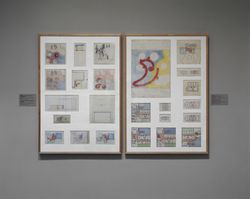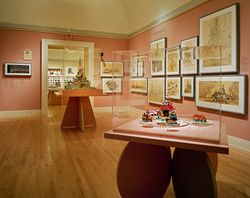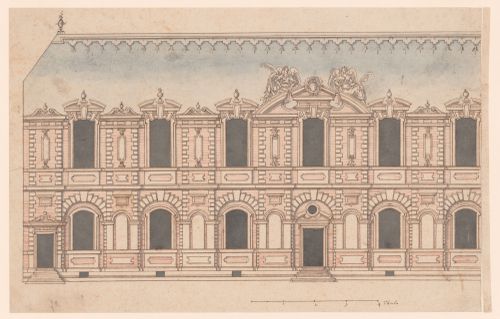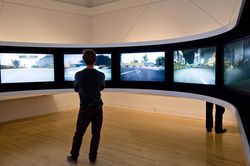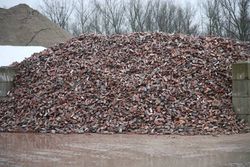photographies
PHCON2002:0016:002:002
Description:
Sheet of 12 square contact prints showing Sebastian Matta posing and playing a guitar; A painting and a drawing by Roberto Matta hang on the wall in the background of most of the photographs.
ca. 1962
Contact sheet of 12 portraits of Sebastian Matta
Actions:
PHCON2002:0016:002:002
Description:
Sheet of 12 square contact prints showing Sebastian Matta posing and playing a guitar; A painting and a drawing by Roberto Matta hang on the wall in the background of most of the photographs.
photographies
ca. 1962
Paul Nelson (1895-1979), architecte, décorateur de cinéma, peintre, critique et professeur, a enseigné et pratiqué l’architecture aux États-Unis et en France pendant plus de cinquante ans. Dans les années 30 et 40, Nelson a été l’une des figures de proue du fonctionnalisme, ce mouvement qui a rejeté le langage Beaux-Arts au profit de l’expression fonctionnelle et(...)
Salles principales
27 mars 1991 au 26 mai 1991
Le crible de la raison : l’oeuvre de Paul Nelson
Actions:
Description:
Paul Nelson (1895-1979), architecte, décorateur de cinéma, peintre, critique et professeur, a enseigné et pratiqué l’architecture aux États-Unis et en France pendant plus de cinquante ans. Dans les années 30 et 40, Nelson a été l’une des figures de proue du fonctionnalisme, ce mouvement qui a rejeté le langage Beaux-Arts au profit de l’expression fonctionnelle et(...)
Salles principales
Série(s)
Architectural projects
AP018.S1
Description:
The Architectural Projects series, 1945-1986, is the largest series in the fonds and documents the projects worked on by Parkin’s two firms throughout his career. These projects include built work, urban planning, proposals, competitions and feasibility studies. The majority of the projects were based in Toronto and the surrounding area, but projects from across Canada and some international projects in the Caribbean, Middle East, and Northern Africa are also included. These individual projects were identified and separated based on distinct project numbers assigned by the creating offices. The general numbering rule at the offices was two digits to represent the year, followed by two or three digits to represent the consecutive project number for that year (YY###). For instance the 7th project taken on in the year 1980 would be assigned the project number 8007. This chronological ordering has been respected in the arrangement of this series. These projects are recorded primarily through textual records and drawings, but some photographs, paintings, artefacts and one book are also included in this series. The amount of drawings and textual materials for the projects vary greatly. Materials for projects before 1971, from the firm John B. Parkin Associates, are very sparse, sometimes with only a few files or drawings representing a project. Materials after 1971, from the firm Parkin Architects Planners, are much more complete and often contain drawings from initial sketches to finished construction work. Among these drawings are plans, elevations, sections, details, perspectives, and mechanical, electrical and structural drawings. Textual records for these projects typically include correspondence, meeting minutes, specifications, site reports, consultancy files and other construction documentation. The photographic materials in this series often show construction progress and completed work. Also present are presentation panels with mounted drawings, photographs and paintings for some projects. The artefacts typically consist of material samples for construction. The textual records for projects are almost always in English, but some drawings are in French or are bilingual for projects commissioned by the Government of Canada. Although John C. Parkin is the creator of this series, the partners at his firms and other employees played a significant role as creators of the contents. Especially in the material from Parkin Architects Planners, the names of his partners such as J.B. Mar, P.H. Warren, D.L. Wilson, and L. Payne are often marked as authors of the materials.
1945-1986
Architectural projects
Actions:
AP018.S1
Description:
The Architectural Projects series, 1945-1986, is the largest series in the fonds and documents the projects worked on by Parkin’s two firms throughout his career. These projects include built work, urban planning, proposals, competitions and feasibility studies. The majority of the projects were based in Toronto and the surrounding area, but projects from across Canada and some international projects in the Caribbean, Middle East, and Northern Africa are also included. These individual projects were identified and separated based on distinct project numbers assigned by the creating offices. The general numbering rule at the offices was two digits to represent the year, followed by two or three digits to represent the consecutive project number for that year (YY###). For instance the 7th project taken on in the year 1980 would be assigned the project number 8007. This chronological ordering has been respected in the arrangement of this series. These projects are recorded primarily through textual records and drawings, but some photographs, paintings, artefacts and one book are also included in this series. The amount of drawings and textual materials for the projects vary greatly. Materials for projects before 1971, from the firm John B. Parkin Associates, are very sparse, sometimes with only a few files or drawings representing a project. Materials after 1971, from the firm Parkin Architects Planners, are much more complete and often contain drawings from initial sketches to finished construction work. Among these drawings are plans, elevations, sections, details, perspectives, and mechanical, electrical and structural drawings. Textual records for these projects typically include correspondence, meeting minutes, specifications, site reports, consultancy files and other construction documentation. The photographic materials in this series often show construction progress and completed work. Also present are presentation panels with mounted drawings, photographs and paintings for some projects. The artefacts typically consist of material samples for construction. The textual records for projects are almost always in English, but some drawings are in French or are bilingual for projects commissioned by the Government of Canada. Although John C. Parkin is the creator of this series, the partners at his firms and other employees played a significant role as creators of the contents. Especially in the material from Parkin Architects Planners, the names of his partners such as J.B. Mar, P.H. Warren, D.L. Wilson, and L. Payne are often marked as authors of the materials.
Series
1945-1986
photographies
Quantité:
32 slide(s)
ARCH270031
Description:
Group consists of photographs of buildings in sector 23 in Chandigarh, India, including schools, group housings and sports installations and clubs. The group also includes photographs of young boys playing baseball.
June 12, 1987
Photographs of buildings in sector 23 in Chandigarh
Actions:
ARCH270031
Description:
Group consists of photographs of buildings in sector 23 in Chandigarh, India, including schools, group housings and sports installations and clubs. The group also includes photographs of young boys playing baseball.
photographies
Quantité:
32 slide(s)
June 12, 1987
Disneyland, avec ses colonies en Floride, au Japon et en France, est un symbole clé de la culture américaine. Très célébré, Disneyland a également été attaqué en tant qu’incarnation suprême de la société de consommation, de la simulation et du pastiche, de la confusion entre la réalité et les images des médias de masse. L’architecture du réconfort : Les parcs thématiques(...)
Salles principales
17 juin 1997 au 28 septembre 1997
L'architecture du réconfort : les parcs thématiques de Disney
Actions:
Description:
Disneyland, avec ses colonies en Floride, au Japon et en France, est un symbole clé de la culture américaine. Très célébré, Disneyland a également été attaqué en tant qu’incarnation suprême de la société de consommation, de la simulation et du pastiche, de la confusion entre la réalité et les images des médias de masse. L’architecture du réconfort : Les parcs thématiques(...)
Salles principales
Elevation of a palace façade
DR1970:0003
Description:
This drawing shows an exterior of a residential building. The artist uses color to suggest the materials used in construction; blue-grey for the pitched slate roof, brown for masonry details and architectural sculpture, and red striations for brickwork. This combination of materials was common in early modern France, where a play on color and materiality enlivened the façades of well-known royal edifices including the chateaux of Fontainebleau and Saint-Germain-en-Laye. As with the construction technique that interwove stone with brick, the architectural style depicted in the drawing combines traditional French ideas about building with classicizing elements imported to France via Italian artists and architects as well as through printed translations of Vitruvius’s 'De architectura' and Sebastiano Serlio’s architectural treatise. The inclusion of masonry rustication and the decorative urns that punctuate the roofline suggest a knowledge of classicizing trends in architectural ornament and a familiarity with the œuvre of artists working in the circle of the first and second Écoles de Fontainebleau. The structure’s elongated form suggests a gallery and the organization of the façade borrows the combination of slightly protruding vertical bays and long horizontal registers that characterizes Pierre Lescot’s wing of the Louvre, a project that would have been well-known in court circles in the latter half of the sixteenth century. Similarly, the two winged allegorical figures flanking the central pediment are reminiscent of Jean Goujon’s sculptural additions to the Lescot wing. In the Canadian Centre for Architecture’s drawing both figures hold palms, but the artist omitted any further identifying attributes, perhaps – along with the empty niches – as an invitation for the patron to imagine his or her own thematic program for the project.
first quarter of the 16th century
Elevation of a palace façade
Actions:
DR1970:0003
Description:
This drawing shows an exterior of a residential building. The artist uses color to suggest the materials used in construction; blue-grey for the pitched slate roof, brown for masonry details and architectural sculpture, and red striations for brickwork. This combination of materials was common in early modern France, where a play on color and materiality enlivened the façades of well-known royal edifices including the chateaux of Fontainebleau and Saint-Germain-en-Laye. As with the construction technique that interwove stone with brick, the architectural style depicted in the drawing combines traditional French ideas about building with classicizing elements imported to France via Italian artists and architects as well as through printed translations of Vitruvius’s 'De architectura' and Sebastiano Serlio’s architectural treatise. The inclusion of masonry rustication and the decorative urns that punctuate the roofline suggest a knowledge of classicizing trends in architectural ornament and a familiarity with the œuvre of artists working in the circle of the first and second Écoles de Fontainebleau. The structure’s elongated form suggests a gallery and the organization of the façade borrows the combination of slightly protruding vertical bays and long horizontal registers that characterizes Pierre Lescot’s wing of the Louvre, a project that would have been well-known in court circles in the latter half of the sixteenth century. Similarly, the two winged allegorical figures flanking the central pediment are reminiscent of Jean Goujon’s sculptural additions to the Lescot wing. In the Canadian Centre for Architecture’s drawing both figures hold palms, but the artist omitted any further identifying attributes, perhaps – along with the empty niches – as an invitation for the patron to imagine his or her own thematic program for the project.
événements
La vitesse et ses limites
La vitesse et ses limites traite de la place importante qu’occupe la vitesse dans la vie moderne, de l’art à l’architecture et à l’urbanisme, en passant par les arts graphiques, l’économie et la culture matérielle de l’ère industrielle et de celle de l’information. Un colloque organisé par le CCA, en collaboration avec la Wolfsonian-Florida International University et le(...)
Théâtre Paul-Desmarais
21 juin 2008, 09h - 17h
La vitesse et ses limites
Actions:
Description:
La vitesse et ses limites traite de la place importante qu’occupe la vitesse dans la vie moderne, de l’art à l’architecture et à l’urbanisme, en passant par les arts graphiques, l’économie et la culture matérielle de l’ère industrielle et de celle de l’information. Un colloque organisé par le CCA, en collaboration avec la Wolfsonian-Florida International University et le(...)
événements
21 juin 2008
09h - 17h
Théâtre Paul-Desmarais
La vitesse et ses limites
La vitesse et ses limite traite de la place prépondérante qu’occupe la vitesse dans la vie moderne, dans les domaines de l’art, l’architecture, l’urbanisme, en passant par celui des arts graphiques, de l’économie et de la culture matérielle de l’ère industrielle et de celle de l’information. Elle souligne le centième anniversaire du futurisme italien, mouvement à qui l’on(...)
Salles principales
20 mai 2009 au 8 novembre 2009
La vitesse et ses limites
Actions:
Description:
La vitesse et ses limite traite de la place prépondérante qu’occupe la vitesse dans la vie moderne, dans les domaines de l’art, l’architecture, l’urbanisme, en passant par celui des arts graphiques, de l’économie et de la culture matérielle de l’ère industrielle et de celle de l’information. Elle souligne le centième anniversaire du futurisme italien, mouvement à qui l’on(...)
Salles principales
documents textuels
Quantité:
6 textual record(s)
6804 / Stadium "Baseball"
ARCH267465
Description:
This group consists of memos, correspondence and related documents concerning the Expo '67 Stadium in Montréal, Québec. There are also clippings of articles from the "Montreal Star" and "The Gazette" about the possibility of having a baseball team playing at the Stadium.
1968
6804 / Stadium "Baseball"
Actions:
ARCH267465
Description:
This group consists of memos, correspondence and related documents concerning the Expo '67 Stadium in Montréal, Québec. There are also clippings of articles from the "Montreal Star" and "The Gazette" about the possibility of having a baseball team playing at the Stadium.
documents textuels
Quantité:
6 textual record(s)
1968
Michael Ghyoot et Maarten Gielen, membres du collectif Rotor, examinent les processus et les pratiques liés à la gestion matérielle des déchets dans Bruxelles et sa banlieue. La notion de déchet, construite à partir des visites rendues par centaines aux commerces, aux lieux de travail et aux centres de tri, a joué un rôle important dans cette recherche. En effet, l’étude(...)
Théâtre Paul-Desmarais
19 avril 2012 , 19h
L'enseignement de... Bruxelles : Rotor
Actions:
Description:
Michael Ghyoot et Maarten Gielen, membres du collectif Rotor, examinent les processus et les pratiques liés à la gestion matérielle des déchets dans Bruxelles et sa banlieue. La notion de déchet, construite à partir des visites rendues par centaines aux commerces, aux lieux de travail et aux centres de tri, a joué un rôle important dans cette recherche. En effet, l’étude(...)
Théâtre Paul-Desmarais
